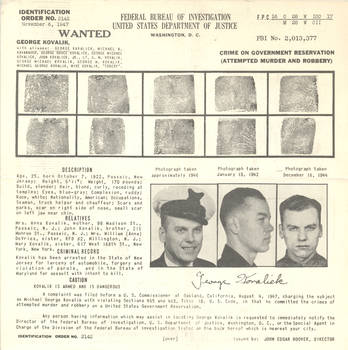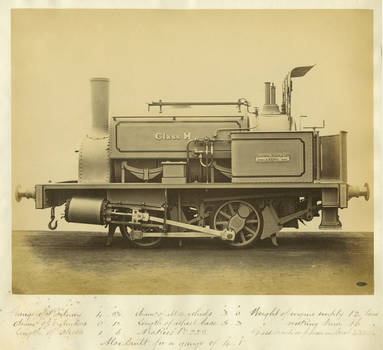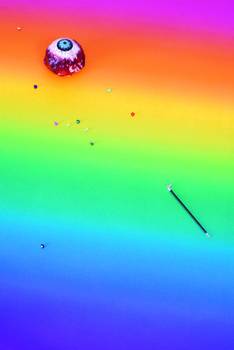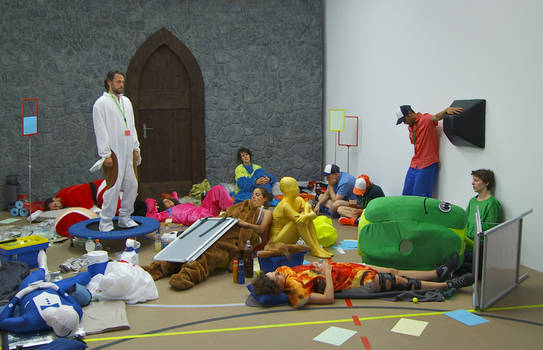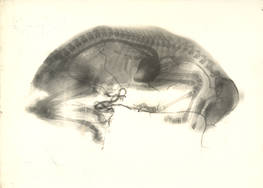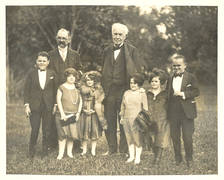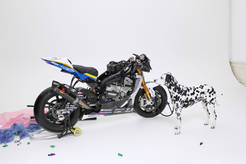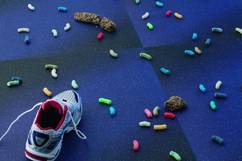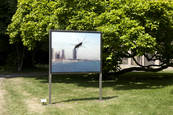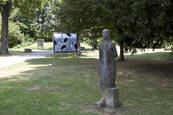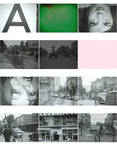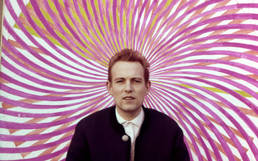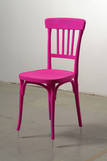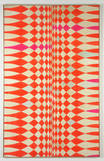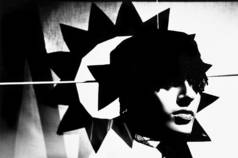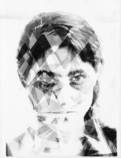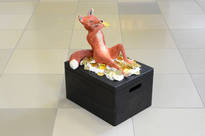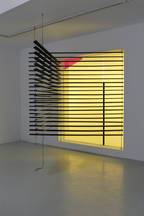15 December 2013 – 16 February 2014
Wozu Bilder?
Gebrauchsweisen der Fotografie
Opening: Sunday, 15 December 2013, 11 am
“What Use Are Pictures?” – especially in today's times, this is a downright radical and simultaneously impertinent question. The same-named exhibition takes as its theme the extremely varied utilizations of photography on the basis of some four hundred photographs from a renowned private collection in southern Germany which are outstanding, even bizarre, sometimes strange, but always astounding.
“Bringing the world home”; “Remembrance”; “Classification”; “Documentation”; “Arousal” – these are a few of the topoi which group examples of historical photography into contentually related picture-tableaus.
“What Use Are Pictures? Utilizations of Photography” at the Villa Merkel turns the customary perspective back onto the medium. The exhibited works have not been selected according to what may be seen upon them or what subjects they offer, but instead with a view to their forms of utilization and application, which are brought to light across a broad spectrum. There are such uses, for instance, as that with the help of photography, nature can be investigated or romanticized, people may be called to mind or traced by the police. Entertaining items may be found under the heading “Jokes.”
These are pictures which cause amusement, induce laughter. They already existed long before the invention of photography. But only photography makes it possible (through montage, multiple lighting, etc.) to allow a lady to engage in a game of chess with herself. Photography has the capacity for making the impossible seem credible …
The exhibition and publication was developed over the course of a two-semester project at the Universität Konstanz in winter 2012/13 and summer 2013 under the supervision of the instructors Bernd Stiegler and Felix Thürlmann.
The exhibition and publication Wozu Bilder? Gebrauchsweisen der Fotografie is receiving generous financial support from the Innovationsfonds Kunst of the State of Baden-Württemberg and, in the context of the initiative of excellence of the Federal Republic and the Federal States, from the cluster of excellence Kulturelle Grundlagen von Integration of the Universität Konstanz.

Fotograf unbekannt<br/>Zwei japanische Damen, um 1880<br/>Kolorierter Albumin-Abzug<br/>26 x 20,8 cm<br/>Privatsammlung
Supported by Innovationsfond Kunst
15 December 2013 – 16 February 2014
Stefan Panhans
Schnee schnell Schnee Du bleiches Reh
Opening: Sunday, 15 December 2013, 11 am
In filmic works, photographs, and installations, Stefan Panhans (*1967) develops pictorial worlds oscillating between documentation and artificiality. Articles from the world of urban consumption such as brand-name gym shoes, fitness equipment, and granola mixtures serve as props in photographic still lifes or are parts of a meticulously prepared décor for film sets. Moving in these scenarios are mask-like, artificial figures that seem to have lost their way between lifestyle, self-optimization, and media hype.
The videos of Stefan Panhans are shot in a single take and do not adhere to a narrative logic. The concentration is upon a pictorial language and carefully staged monologues and dialogues. There is frequent use of sampling techniques which take up advertising slogans, slang expressions, or marketing language. In the video “ Sieben bis Zehn Millionen” (“Seven to Ten Million”), for example, a person describes at breakneck speed the complications which can arise when purchasing technical equipment. Only upon a second look does the face of the speaking man, wrapped in a fashionable hood with fur collar, reveal itself to be that of a woman. The viewer himself is manipulated in ambivalent images which conceal several layers behind their superficially shining advertising optics.
The video “Sorry” has almost no language at all. It takes place in the overcrowded pullman car of an intercity express train. People shove their way past each other and climb over heaps of gaudily colored luggage. An everyday image in a second-class carriage of the German Railway—if it were not the case that every person is wearing an exaggerated costume inspired by a role model from the world of art and media. Things which seem to have no affinity with each other are fitted together into an opulent image of our era.
The photographs as well are unexpected stagings of contemporary lifestyle and a persiflage on the mechanisms of advertising photography. For the exhibition at the Villa Merkel, a series of photographs have been newly produced and are being presented for the first time.
In addition, the exhibition at the Villa Merkel features several video works. In the framework of the exhibition, a section of the Villa Merkel itself serves as the setting for a new video by Stefan Panhans. The setting will remain in place while the newly-produced video is presented at the Haus am Waldsee in Berlin, starting on January 19, 2014.
Stefan Panhans lives and works in Berlin and Hamburg.
Solo Exhibitions (Selection):
2014 “Too much Change is not enough,” Haus am Waldsee, Berlin; 2013 “The Long Goodbye (Pre-Afterwork-Ok-Clubset) Casino,” Project in a Public Space, Steintorplatz, Hamburg; “Untitled & Items for Possible Video Sets - FW Run / SORRY Homestory,” FELDBUSCHWIESNER, Berlin; 2012 “Stefan Panhans - Untitled & Items for Possible Videosets - Concrete Run,” 'Art is Concrete. And so is Truth?', Camera Austria / Steirischer Herbst, Kunsthaus Graz; 2011 “Wann kommt eigentlich der Mond raus?”, Museum für Gegenwartskunst, Siegen
Group Exhibitions (Selection):
2013 “Utopien vermeiden,” Werkleitz Biennale, Halle (Saale); “FORMER WEST, Notes from Berlin,” BAK, basis voor actuele Kunst, Utrecht; “HIS MASTER’S VOICE: Von Stimme und Sprache,” Medienkunstverein Dortmund; “FORMER WEST: Documentations, Constellations, Prospects,” Haus der Kulturen der Welt, Berlin; “In was bin ich da reingerutscht? Existenz und Identität in der Kunst,” Kunsthalle zu Kiel; 2012 “Keine Zeit – Erschöpftes Selbst/ Entgrenztes Können,” Belvedere 21er Haus, Vienna; “Uncanny Home,” Corridor, Reykjavik; “Über die Dinge,” Kulturstiftung Schloss Agathenburg; 2011 “Von der Sehnsucht nach Glanz und Gloria,” (Videoscreening), Museum Ludwig /ISEA2011I Istanbul; “Schon wieder und noch mal – Handlungsspielräume?”, Kunstverein Medienturm, Graz; “Schlaf und Traum. Für eine Praxis des Horizontalen,” Shedhalle, Zürich
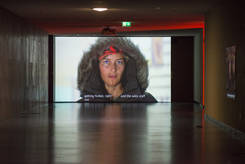
Stefan Panhans<br/>Sieben bis Zehn Millionen, 2005<br/>HDV, 16:9, Farbe, Ton, 5:30 Min.<br/>Installationsansicht „Former West: Documents, Constellations, Prospects“, Haus der Kulturen der Welt, Berlin<br/>Foto: Marcus Lieberenz<br/>Stefan Panhans / Feldbuschwiesner, Berlin / Galerie Dorothea Schlueter, Hamburg
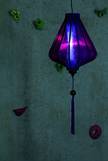
Stefan Panhans<br/>Items for Possible Video Sets #27, 2011<br/>C-Print, 80 x 53 cm<br/>Stefan Panhans / Feldbuschwiesner, Berlin / Galerie Dorothea Schlueter, Hamburg
Kindly supported by
19 July to 6 October 2013
Crossing Media – A Stage for Art
Opening: Thursday, 18 July 2013, 7 pm
Including works by Nevin Aladag (TR/DE), Julien Berthier (FR), Birgit Brenner (DE), Daniele Buetti (CH), Kurt Caviezel (CH), Beate Engl (DE), Rainer Ganahl (AT/US), Johan Grimonprez (BE), Paul Harrison/John Wood (GB), Christine Hill (US), Eva Kotatkova (CZ), Jung Lee (KR), Alexandra Leykauf (DE), Atelier van Lieshout (NL), Andres Lutz/Anders Guggisberg (CH), Philippe Ramette (FR), Banks Violette (US).
„Crossing Media – Der Kunst die Bühne“ [the stage given over to art] is an attractive festival of contemporary Art in Esslingen which has developed out of the International Foto Triennale. In 2013 the galleries of the city of Esslingen have focused increasingly on positions of the crossover, which, starting off from photographic approaches, provide a stage for performance and interactive tendencies on an equal footing. The art and media Triennale is building bridges between disciplines and genres, in which visual arts is related to theatre, music and language. Artistic positions of photography, video arts, installation down to performance that will be presented.
In the interplay of artistic approaches there lies the potential of testing unknown territory, of questioning social relations and further developing traditional genres. On the basis of photographs, Alexandra Leykauf
composers walk-in visual worlds in black and white; in the video projection “10 x 10” 2011, Paul Harrison and John Wood playfully suspend the space; in the real stage design of “Shop/Like” 2011, by Christine Hill, visitors negotiate the everyday situation of a shop through physical and photographic appropriation, or the “Paravent” 2012, an apparent stage requisite by Nevin Aladag, confronts the visitor with intercultural interrelationships in our society.
The “Crossing Media” art festival is presented in the Villa Merkel and the Bahnwärterhaus. The Merkel Park in Esslingen is presented for the first time as a stage and an attractive Art Park. The exhibition is accompanied by a varied and entertaining side programme which takes a close look at the subject of the crossover in the arts in terms of events, discourses and educational programmes. In particular in open-air events and insight will be provided into various different artistic positions. Among other things, artist videos will be presented in summer nights, and musical and audio events will explore the interaction of arts and music, and of acoustic art respectively.
A multiple-part publication to accompany the exhibition will appear in stages.

Eva Kotátková<br/>Rehearsal Room, 2013<br/>Zeichnungen, Collagen, Manuskriptseiten, Tisch, Stühle, Schreibmaschine, Holzpuppe<br/>Courtesy Galerie Meyer Riegger, Berlin/Karlsruhe<br/>Ausstellungsansicht Crossing Media 2013, Villa Merkel<br/>Foto: Daniela Wolf

Jung Lee<br/>Aporia # 2, 2013<br/>Neonröhren, Transformatoren, Silikon, Draht, Kabel<br/>Courtesy Jung Lee<br/>Ausstellungsansicht Crossing Media 2013, Villa Merkel<br/>Foto: Daniela Wolf

Kurt Caviezel<br/>Dancer, 2011<br/>Internet-Video, 2:17 Min.<br/>Ausstellungsansicht Crossing Media 2013, Villa Merkel<br/>Foto: Daniela Wolf

Nevin Aladag/Beate Engl<br/>Top View 29.53 Ft., 2012<br/>Gerüstskulptur, LED Screen, Video<br/>Courtesy Nevin Aladag, Beate Engl und Galerie Wentrup, Berlin<br/>Ausstellungsansicht Crossing Media 2013, Villa Merkel<br/>Foto: Daniela Wolf

Philippe Ramette<br/>Exploration rationnelle des fonds sous–marins: la sieste, 2006<br/>Farbfotografie<br/>Courtesy Galerie Xippas<br/>Ausstellungsansicht Crossing Media 2013, Villa Merkel<br/>Foto: Daniela Wolf
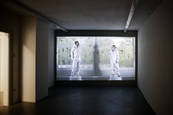
Nevin Aladağ<br/>Significant Other, 2011<br/>HD Video, 15:00 Min.<br/>Courtesy Wentrup Berlin und Nevin Aladağ<br/>Ausstellungsansicht Crossing Media 2013, Villa Merkel<br/>Foto: Daniela Wolf

Atelier van Lieshout<br/>Workskull, 2005<br/>Glasfaserverstärkes Polyester, Holz, Kunstfell<br/>Courtesy Atelier Van Lieshout<br/>Ausstellungsansicht Crossing Media 2013, Villa Merkel<br/>Foto: Daniela Wolf

Banks Violette<br/>Kill Yourself (Twin), 2006<br/>Verzinkte Stahlrohre, Stahl, Aluminium, Sperrholz, getöntes Epoxidharz, Fluoreszenzröhren mit Fassung, 3 Flightcases<br/>Courtesy Sammlung Migros Museum für Gegenwartskunst<br/>Ausstellungsansicht Crossing Media 2013, Villa Merkel<br/>Foto: Daniela Wolf

Christine Hill<br/>Small Business Model, 2011<br/>Podest, Tresen, Regale, Interieur<br/>Courtesy Galerie Eigen + Art, Leipzig / Berlin<br/>Ausstellungsansicht Crossing Media 2013, Villa Merkel<br/>Foto: Daniela Wolf

Daniele Buetti<br/>Waving the Sky, 2005–2006<br/>Videoprojektor, Stühle, Tisch, 4:31 Min.<br/>Courtesy Daniele Buetti und Aeroplastics contemporary, Brüssel<br/>Ausstellungsansicht Crossing Media 2013, Villa Merkel<br/>Foto: Daniela Wolf
Supported by

Partner

28 April - 30 June 2013
Manfred Kuttner
Werkschau
Opening: Sunday, 28 April, 11 a.m.
Manfred Kuttner (1937-2007) was one of the co-founders of Capitalist Realism. In 1963 he organised the legendary Demonstrative exhibition in the Kaiserstraße, Düsseldorf, together with his artist friends and colleagues Konrad Lueg, Sigmar Polke and Gerhard Richter. The exhibition can be seen as the nucleus of the so-called German Pop Art and of the worldwide success of Sigmar Polke, Gerhard Richter and the later gallery owner, Konrad Fischer. In 1967 Manfred Kuttner moved into the field of advertising art, ending his artistic career almost before it had properly begun.
The abstract, geometrically structured pictures and neon-coloured objects of Manfred Kuttner from the early 60s range ambivalently between such different styles as Op art, Pop art, Zero art, Informel and Nouveau Réalism. His use of the then brand-new Plaka fluorescent paint created a shimmering surface, invalidating attempts at classification.
From today's perspective, in the context of neo-abstract painting debates, Manfred Kuttner's pictures seem highly relevant. After more than 45 years, this show, assembled by the Villa Merkel together with the Langen Foundation, provides the first institutional overview of this oeuvre, terminated at an early stage. Along with paintings and drawings, objects, photographs and contemporary documents are presented, as well as his until now rarely shown film, A-Z, made in 1963.
To coincide with the exhibition, the first monograph on Manfred Kuttner is being published with essays by Christine Mehring, Birgit Hein, Franz Erhard Walther and Thomas Scheibitz, and a catalogue of works prepared by Sabine Sense.
The exhibition is curated by Marcus Weber, Andreas Baur and Christiane Maria Schneider.

Manfred Kuttner<br/>Lohe, 1963<br/>Tempera, floureszierende Leuchtfarbe auf Dekostoff<br/>88 x 160 cm<br/>Collection Eric Diefenbach and James Keith Brown, New York

Manfred Kuttner<br/>Zwie, 1964<br/>Tempera, floureszierende Leuchtfarbe auf Deco<br/>140 x 111 cm<br/>Collection Jill and Peter Kraus, New York
28 April - 30 June 2013
Lena Münch
Splitter. Fotografie und Dinge
Debut exhibition at the Bahnwärterhaus
Opening: Sunday, 28th April 2013, 11am
„Lena Münch – Sliver. Photography and Things“ is the second debut exhibition this year in cooperation with the Staatlichen Akademie der Bildenden Künste Stuttgart.
In analogue photographs in black and white, Lena Münch combines and varies her impressions, experiences and perspectives on the world in diverse ways. The majority of the starting material for her artistic work includes found and ordinary things. These slivers of the world – mostly disconnected, partly antagonistic raw materials – are combined by Lena Münch into temporary and atmospheric realities.
The photographs present high precision as well as freedom in the intuitive use of the accidental. Using photographic techniques ranging from classical to experimental, Lena Münch playfully assembles exact compositions in which the objects and forms
are organized in relation to each other and are elevated to the role of theatrical protagonists. Not only do the objects in the photograph assert a haptic presence;
they also occupy space.
Lena Münch (*1980 Stuttgart) studied from 2003 until 2009 at the Staatlichen Akademie der Bildenden Künste Stuttgart and at the Accademia delle Belle Arti di Brera in Milan. She attended classes of Free Graphic Design, Painting, and Sculpture with, among others, Prof. Andreas Opiolka, Prof. Franco Marrocco, Prof. Paolo Gallerani, and Prof. Reto Boller.
On the occasion of the exhibition a hybrid between picture-book and catalogue is being published: „Das mit dem Leben und der Liebe“, wherein the artist creates a picture-story from her observations, experiences, and dreams.
17 February - 14 April 2013
Goldrausch
contemporary art made from, with or about gold
Opening: 17 February 2013 11 a.m.
Villa Merkel
Pawel Althamer, Joseph Beuys, Michał Budny, Anja Ciupka, Jürgen Drescher, Felix Gonzalez-Torres, Filip Gilissen, Daniel Knorr, Alicja Kwade, Kris Martin, Jonathan Monk, Alexandra Müller, Roman Ondák, Martin Pfeifle, Claus Richter, Michael Sailstorfer, Johannes Vogl and Claudia Wieser
In cooperation with Kunsthalle Nürnberg, Nuremberg
18 October 2012 to 13 January 2013
Curator of the exhibition: Dr. Harriet Zilch
www.kunstkulturquartier.de/kunsthalle
Catalogue German/English
Verlag für moderne Kunst Nürnberg
ISBN 978-3-86984-387-2
24,- Euro during the exhibition at Villa Merkel
32,- Euro in bookshops

Filip Gilissen<br/>I Love New Work, 2007<br/>wendbare Pailletten (goldfarbene Vorderseite & schwarze Rückseite) als Schriftzug angelegt<br/>Courtesy Filip Gilissen
17. Februar – 14. April 2013
Julien Viala
The memory of space
Debütausstellung im Bahnwärterhaus
Akademie der Bildenden Künste Stuttgart
Die Ausstellung „Julien Viala. The memory of space“ markiert den Start einer neuen Projektreihe. Zukünftig werden jährlich jeweils 2 Debütausstellungen in Kooperation mit der Staatlichen Akademie der Bildenden Künste Stuttgart im Bahnwärterhaus präsentiert.
Die Ausstellung von Julien Viala (*1978 München) umfasst Objekte, Artefakte, Fotografien, Installationen und Projektionen. Genreübergreifend streifen die Arbeiten Bereiche wie Architektur, Design und Skulptur. Dabei verbinden sich die einzelnen Teile zu ortsspezifischen Arrangements. Diese werden durch Lichtprojektionen in eine künstliche Atmosphäre versetzt. Für den Betrachter entsteht der Eindruck, eine Bühne von hinten zu betreten.
Julien Viala thematisiert den Wechsel zwischen Realität und Schein eines Ortes. Die skulptural orientierten Raumkompostionen lassen auf mögliche oder auch vorgetäuschte Funktionen schließen, die auch mit dem speziellen Ort Bahnwärterhaus zusammenhängen. Eine genaue Defintition wird jedoch nicht gegeben. Die Objekte fügen sich zu einem offenen Gesamteindruck und geben der Täuschung und dem Unwahrscheinlichen Raum.



